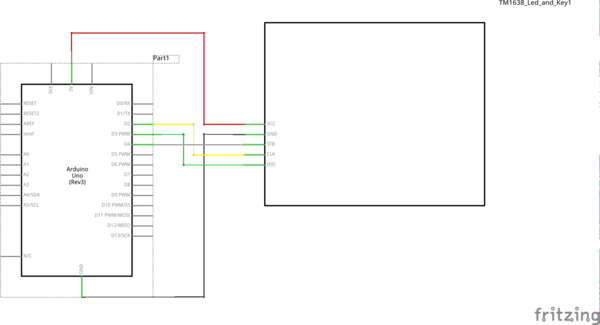LED-Key Modul am Arduino
Anschluss des HC-SR04 an den Arduino
zum Anschluss des LED-Key Board an ein Arduino Board werden drei I/O Pins benötigt.
Programm für den Arduino
Das Arduino Demo aus dem Make-Magazin 4/18 zeigt die Ausgabe auf der 7-Segment-Anzeige und den LEDs, sowie die Abfrage der Tasten per Soft-SPI.
/*
* Make: 4/2018
* Minimalistisches Beispiel zur Ansteuerung eines TM1638 mit 8-Digit 7-Segment-LED per Software-SPI, 8 LEDs und 8 Buttons
* Idee: https://github.com/MartyMacGyver/TM1638-demos-and-examples
*/
#include <SPI.h>
// Wir nutzen Software-SPI. Pins frei wählbar:
const uint8_t TM1638_CS=4;
const uint8_t TM1638_CLK=2;
const uint8_t TM1638_DATA=3;
/*
* @brief Sendet Wert per SPI, togglet CLK
* @param Wert
* @return none
*/
void sendCommand(uint8_t value)
{
digitalWrite(TM1638_CS, LOW); // Modul CS
shiftOut (TM1638_DATA, TM1638_CLK, LSBFIRST, value);
digitalWrite(TM1638_CS, HIGH);
}
/*
* @brief Initialisiert Display
* @param none
* @return none
*/
void sendReset()
{
// Flowchart for program design in the modes of auto address increment by 1 and fixed address:
sendCommand(0x40); // Set command for writing data into display memory, in the mode of auto address increment by 1
digitalWrite(TM1638_CS, LOW); // Besonderheit: kein CS Toggle waehrend der Uebertragung
shiftOut (TM1638_DATA, TM1638_CLK, LSBFIRST, 0xC0); // set starting address (0x0C0)
for(uint8_t i = 0; i < 16; i++)
shiftOut (TM1638_DATA, TM1638_CLK, LSBFIRST, 0x00); // 16x 0 senden
digitalWrite(TM1638_CS, HIGH);
}
/*
* @brief Gibt die Zahlen 0..9 nacheinander gleichzeitg auf allen Stellen aus
* Definiert die anzuzeigenden Segmente fuer jede Zahl
* @param none
* @return none
*/
void counting()
{
//0// //1// //2// //3// //4// //5// //6// //7// //8// //9//
uint8_t digits[] = { 0x3f, 0x06, 0x5b, 0x4f, 0x66, 0x6d, 0x7d, 0x07, 0x7f, 0x6f };
uint8_t value;
for (uint8_t value=0; value <= 9; value++)
{
sendCommand(0x40); //Set command for writing data into display memory, in the mode of auto address increment by 1
digitalWrite(TM1638_CS, LOW); // Besonderheit: kein CS Toggle waehrend der Uebertragung
shiftOut (TM1638_DATA, TM1638_CLK, LSBFIRST, 0xC0); // set starting address (0x0C0)
for(uint8_t i = 0; i < 8; i++)
{
shiftOut (TM1638_DATA, TM1638_CLK, LSBFIRST, digits[value]); // Wert
shiftOut (TM1638_DATA, TM1638_CLK, LSBFIRST, 0x00);
}
digitalWrite(TM1638_CS, HIGH);
delay (500);
}
}
/*
* @brief Gibt Text aus. Funktioniert im Prinzip wie Zahlenausgabe, nur mit eigenen Zeichen
* Definiert die anzuzeigenden Segmente fuer jede Zahl
* @param none
* @return none
*/
void text()
{
uint8_t scrollText[] =
{
//H// //E// //L// //L// //O// //.// //.// //.//
0x76, 0x79, 0x38, 0x38, 0x3f, 0x80, 0x80, 0x80
};
sendCommand(0x40);
digitalWrite(TM1638_CS, LOW);
shiftOut (TM1638_DATA, TM1638_CLK, LSBFIRST, 0xc0);
for(int i = 0; i < 8; i++)
{
shiftOut (TM1638_DATA, TM1638_CLK, LSBFIRST, scrollText[i]); // Wert
shiftOut (TM1638_DATA, TM1638_CLK, LSBFIRST, 0x00);
}
digitalWrite(TM1638_CS, HIGH);
delay (3000);
}
uint8_t readButtons(void)
{
uint8_t buttons = 0;
digitalWrite(TM1638_CS, LOW);
shiftOut (TM1638_DATA, TM1638_CLK, LSBFIRST, 0x42);
// Ab jetzt Daten empfangen:
pinMode(TM1638_DATA, INPUT);
for (uint8_t i = 0; i < 4; i++)
{
uint8_t v = shiftIn (TM1638_DATA, TM1638_CLK, LSBFIRST) << i; // Daten einlesen, kein MISO sondern gleicher Pin wie MOSI
buttons |= v;
}
pinMode(TM1638_DATA, OUTPUT); // wieder als Eingang
digitalWrite(TM1638_CS, HIGH);
return buttons;
}
/*
* @brief Schaltet eine LED an (1) oder aus (0)
* @param Zustand
* LED (0=links)
* @return none
*/
void setLed(uint8_t value, uint8_t position)
{
sendCommand(0x44);
digitalWrite(TM1638_CS, LOW);
shiftOut (TM1638_DATA, TM1638_CLK, LSBFIRST, 0xC1 + (position << 1));
shiftOut (TM1638_DATA, TM1638_CLK, LSBFIRST, value);
digitalWrite(TM1638_CS, HIGH);
}
/*
* @brief Laesst die LEDs nacheinader leuchten
* @param none
* @return none
*/
void lauflicht ()
{
for (uint8_t i=0; i<=7; i++)
{
setLed (1, i);
delay (200);
setLed (0, i);
}
}
/*
* @brief Fragt die Taster ab und laesst die passende LED leuchten
* @param none
* @return none
*/
void taster ()
{
uint8_t buttons = readButtons();
uint8_t position, mask;
for(position = 0; position < 8; position++)
{
mask = 0x01 << position;
setLed(buttons & mask ? 1 : 0, position);
}
}
void setup()
{
digitalWrite(TM1638_CS, HIGH);
digitalWrite(TM1638_DATA, LOW);
digitalWrite(TM1638_CLK, LOW);
pinMode(TM1638_CS, OUTPUT);
pinMode(TM1638_DATA, OUTPUT);
pinMode(TM1638_CLK, OUTPUT);
sendCommand(0x8F); // Display ON, max. Helligkeit
sendReset();
}
void loop()
{
counting();
text();
lauflicht();
sendCommand(0x88); // Display ON, min. Helligkeit (Datenblatt Kap. 5.3)
while (1)
taster();
}
